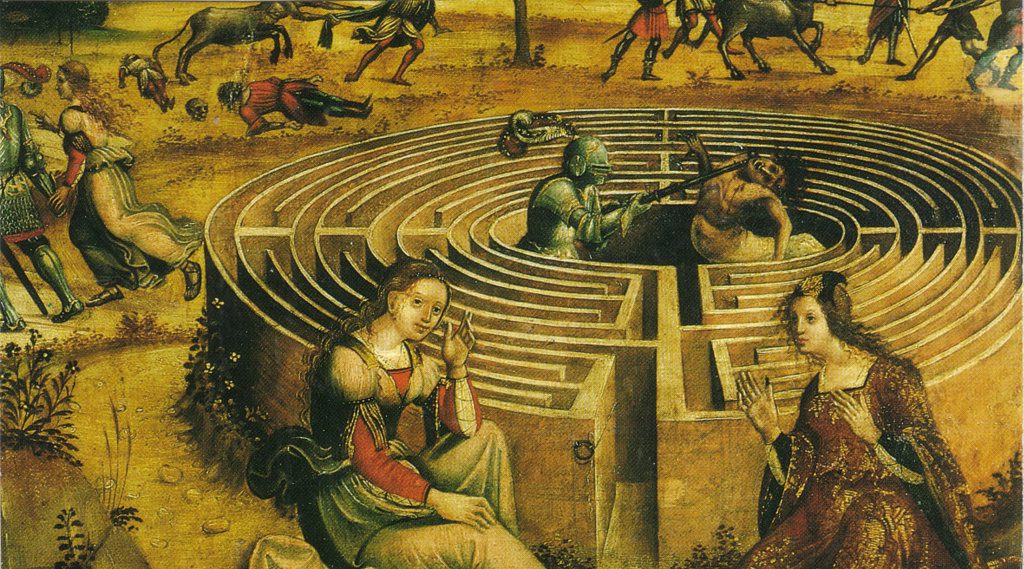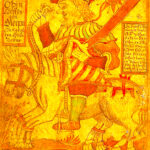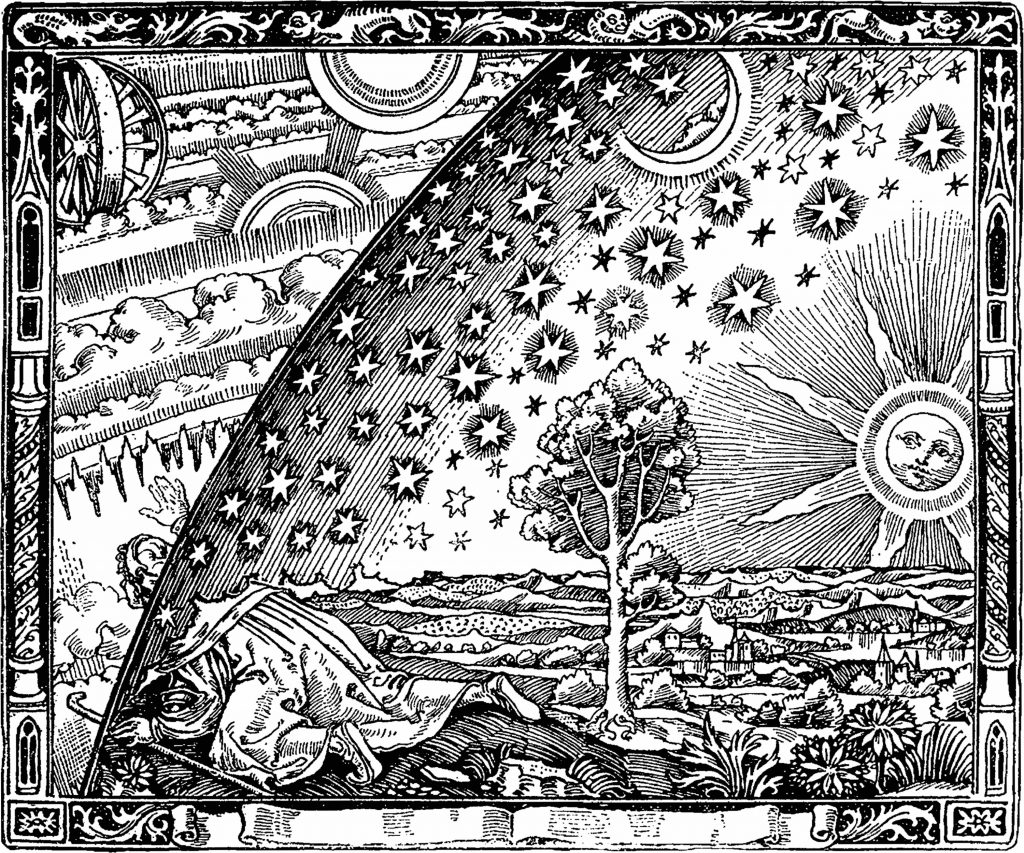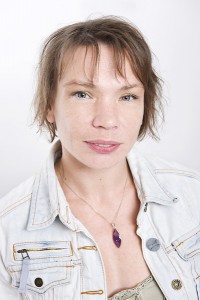This blog is about symbols and their meaning. The world is filled with symbols. Success in life is often the result of interpreting symbols in an adequate manner.

Symbols and Mythology
Ariadne is the goddess of passion. She is the daughter of Midos, King of Crete, and Pasiphae. She helped Theseus battle the Minotaur who was stuck in the labyrinth. Ariadne gave him the clue to escape out of wandering around in a pool of possibilities. A simple woollen thread, that enabled him to find his way back. But she did not only show him the path, she also helped him to concur the monster that was hiding in the dark, by giving him a sword. She did all that for the promise of marriage. Theseus promised to marry her as soon as he came back from his mission. But he left her. Poor Ariadne…
Dionysius married her and they allegedly had two children: Stapylus and Oenopion.
Dream Symbols and Ariadne
Anthony Stevens writes in his book Ariadne’s Clue, A guide to the symbols of humankind: “Theseus’s daring expedition into the Labyrinth resembles the journey of other heroes such as Orpheus and Aeneas into the Underworld, the realm of ancestors and the unconscious… The thread has been rich in symbolic significance ever since women discovered the art of spinning and weaving – activities as distinctive feminine as ploughing is masculine. For both man and women weaving and ploughing provide means of participating in the work of creation, and, as a consequence, they have worldwide religious and ritual significance”.
All of us who have tried to battle our mosters know that in emotional times you are best guided by logical thinking. It serves as a key to get you out of the labirinth of your emotions. “Keep your head together” is what all mothers say to their children in times of trouble. Good advice, but it can be so hard to find Ariadne’s thread…

Part one of Ariadne’s clue is devoted to symbolism, evolution, and psychology. The second part is and explanatory thesaurus. I will pick some cherries of the pie to convince you of the beauty of this book.
Symbols and Dreams
Dreams are filled with symbols. But (how) do these symbols in dreams relate to symbols used in mythological tales? Otto Rank, Austrian psychoanalytic therapist and writer said: “The myth is the collective dream of the people”.
Anthony Stevens proposes to review the meaning of symbols assembled into four groups. Symbols relating to the physical environment, culture and psyche, people animals and plants and the body.
Ok, now you are going to say: “This is interesting but incredibly vague”. I agree. the value of this book lies in its ability to structure the wealth of symbols in culture and mythology. This is indeed a very ambitious task. Anthony Stevens cuts through layers of meaning, defines concepts, and tries to create understanding of symbolism. This does not always bring more clarity. But you got to like the man for making such an effort. You know by reading Ariadne’s clue that writing this book must have taken him several years.
Symbols and Ariadne’s Clue
I like and value the book for the ease with wich it brings more structure into your mythological knowledge. Let me give you an example. “Some authorities have postulated the existence of an original sky god, Dieus, common to all Indo-European tribes, from which later sky gods evolved. However, a prototypical sky god is not a necessary postulate in view of the readiness with wich the magnificence of heaven can evolve hierophantic experience. The Indian god Dyaus, the greek god Zeus, the Roman Jupiter and the germanic Tyr-zio are all expressions of the same archetype projected on to the celestial vault”.
I like that. It strengthens my intuitive assumption that human beings all have the same origin, the same ancestry and therefore the same challenges in live.
The book can be confusing sometimes. Anthony Stevens needlessly complicates the book by giving lengthy definitions that should explain symbols. Let me give you another example. “Symbols invariably (1) celebrated the interdependence of like phenomena and (2) developed the ‘sacred technology’ necessary (3) to facilitate human participation in natural phenomena and (4) to mobilize helpful assistance from the gods”. Even though the points get explained, it sometimes confuses me instead of bringing more structure.
Conclusion: to buy or not to buy?
Please buy the book. You will not be sorry. Even if you do not read it at once, you will have a thesaurus filled with symbols in your book shelf. The way the book connects themes, archetypes and mythologies will thrill everyone who is interested in mythology and dreams.
Are you interested in Mythology? Mindfunda Mytholgy Online course would be something to explore: Mindfunda Courses
Youtube
Facebook
Online Courses
Free ebook
THIS CONTENT IS CREATED BY SUSANNE VAN DOORN, AUTHOR AND OWNER OF MINDFUNDA; MAKING THE FUNDAMENTALS OF PSYCHOLOGY, MYTHOLOGY AND SPIRITUALITY EASY TO USE IN YOUR PERSONAL LIFE!
What is Mindfunda about?
My name is Susanne van Doorn, I am a Dutch psychologist, blogger and author. I have been working with psychology, dreams and mythology ever since I finished my study in psychology at Tilburg University. I made this independant site to share insights, and recent scientific articles about the brain, dreams, and mythology for use in your personal life.
This posting is categorised as Mythofunda:
“Myths are public dreams, dreams are private myths” Joseph Campbell used to say. This part of Mindfunda shows you how your personal mythology can create peace in your life.
Read more about Mindfunda here, or visit our Courses Page.
(Ready for more free Mindfunda content on ‘#MYTHOLOGY‘?

Chasing the Light

Odin Opens Up this Year’s Christmas Celebration
The Good, The Bad and The Ugly
Comments or suggestions? Share your thoughts:




It’s one of my favourite books Susanne, one that I refer to fairly often. Great to see you highlighting it here!